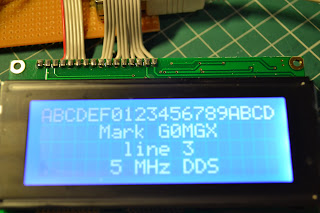Following on from my previous post; I've been busy boxing my DDS.
I bought a case from my local Maplin, it's the same case as my digital modes interface is boxed in from here:
http://g0mgx.blogspot.com/2011/10/how-come-its-siuch-damn-mess-again.html
I'm totally useless at cutting metal, so a plastic enclosure is the only real option if I want to do this myself, here is the front panel (with the display upside down) taking shape:
And placed into the outer frame:
Some clothes pegs hold it all together whilst the glue sets:
And here it is, finished:
Not bad, egh?
I bought a case from my local Maplin, it's the same case as my digital modes interface is boxed in from here:
http://g0mgx.blogspot.com/2011/10/how-come-its-siuch-damn-mess-again.html
I'm totally useless at cutting metal, so a plastic enclosure is the only real option if I want to do this myself, here is the front panel (with the display upside down) taking shape:
And placed into the outer frame:
Some clothes pegs hold it all together whilst the glue sets:
And here it is, finished:
Not bad, egh?












